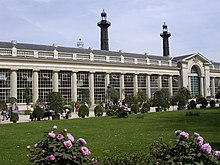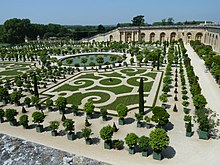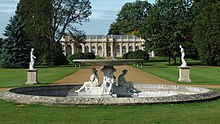
Historically, a kiosk was a small garden pavilion open on some or all sides common in Persia, the Indian subcontinent, and in the Ottoman Empire from the 13th century onward. Today, several examples of this type of kiosk still exist in and around the Topkapı Palace in Istanbul, and they can be seen in Balkan countries.
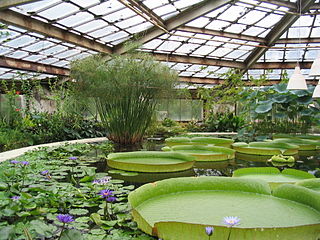
A greenhouse is a special structure that is designed to regulate the temperature and humidity of the environment inside. There are different types of greenhouses, but they all have large areas covered with transparent materials that capture sunlight and heat. The most common materials used in modern greenhouses for walls and roofs are rigid plastic made of polycarbonate, plastic film made of polyethylene, or glass panes.. When the inside of a greenhouse is exposed to sunlight, the temperature increases, providing a sheltered environment for plants to grow even in cold weather.

Sir Joseph Paxton was an English gardener, architect, engineer and Member of Parliament, best known for designing the Crystal Palace and for cultivating the Cavendish banana, the most consumed banana in the Western world.

A conservatory is a building or room having glass or other transparent roofing and walls, used as a greenhouse or a sunroom. Usually it refers to a space attached to a conventional building such as a house, especially in the United Kingdom. Elsewhere, especially in America, it can often refer to a large freestanding glass-walled building in a botanic garden or park, sometimes also called a palm house if tall enough for trees. Municipal conservatories became popular in the early 19th century.

A walled garden is a garden enclosed by high walls, especially when this is done for horticultural rather than security purposes, although originally all gardens may have been enclosed for protection from animal or human intruders. In temperate climates, especially colder areas, such as Scotland, the essential function of the walling of a garden is to shelter the garden from wind and frost, though it may also serve a decorative purpose. Kitchen gardens were very often walled, which segregated them socially, allowing the gardeners, who were usually expected to vanish from the "pleasure gardens" when the occupants of the house were likely to be about, to continue their work. The walls, which were sometimes heated, also carried fruit trees trained as espaliers.

The Conservatory of Flowers is a greenhouse and botanical garden that houses a collection of rare and exotic plants in Golden Gate Park, San Francisco, California. With construction having been completed in 1879, it is the oldest building in the park. It was one of the first municipal conservatories constructed in the United States and is the oldest remaining municipal wooden conservatory in the country. For these distinctions and for its associated historical, architectural, and engineering merits, the Conservatory of Flowers is listed on the National Register of Historic Places and the California Register of Historical Places. It is a California Historical Landmark and a San Francisco Designated Landmark.

The Herrenhausen Gardens of Herrenhausen Palace are located in Herrenhausen, an urban district of Hanover, the capital of Lower Saxony, Germany. Dating to the era of the Kings of Hanover, they comprise Great Garden, Hill Garden, Georgen Garden and Guelf Garden.
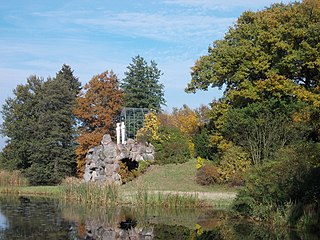
The Dessau-Wörlitz Garden Realm, is a cultural landscape and World Heritage Site in Germany, located between the city of Dessau and the town of Wörlitz in Central Germany. One of the first and largest English parks in Germany and continental Europe, it was created in the late 18th century under the regency of Duke Leopold III of Anhalt-Dessau. Today, the cultural landscape of Dessau-Wörlitz encompasses an area of 142 km2 (55 sq mi) within the Middle Elbe Biosphere Reserve in the German state of Saxony-Anhalt. Because of its exceptional landscape design and testimony to the ideals of the Age of Enlightenment, the Dessau-Wörlitz Garden Realm was designated as a world heritage site in 2000.

The Musée de l'Orangerie is an art gallery of impressionist and post-impressionist paintings located in the west corner of the Tuileries Garden next to the Place de la Concorde in Paris. The museum is most famous as the permanent home of eight large Water Lilies murals by Claude Monet, and also contains works by Paul Cézanne, Henri Matisse, Amedeo Modigliani, Pablo Picasso, Pierre-Auguste Renoir, Henri Rousseau, Alfred Sisley, Chaïm Soutine, Maurice Utrillo, and others.
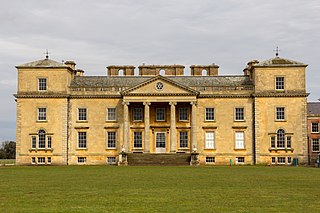
Croome Court is a mid-18th-century Neo-Palladian mansion surrounded by extensive landscaped parkland at Croome D'Abitot, near Upton-upon-Severn in south Worcestershire, England. The mansion and park were designed by Lancelot "Capability" Brown for the 6th Earl of Coventry, and they were Brown's first landscape design and first major architectural project. Some of the mansion's rooms were designed by Robert Adam. St Mary Magdalene's Church, Croome D'Abitot that sits within the grounds of the park is now owned and cared for by the Churches Conservation Trust.

</ref>

The Royal Greenhouses of Laeken are a vast complex of monumental heated greenhouses in the park of the Royal Palace of Laeken, Belgium. The historic complex contains tropical, subtropical and cold greenhouses, and is home to the famous Royal Botanic Collection, which includes large collections of camellias, orange trees and many plants originating from the African parts of the former Belgian Empire.

A roof lantern is a daylighting architectural element. Architectural lanterns are part of a larger roof and provide natural light into the space or room below. In contemporary use it is an architectural skylight structure.
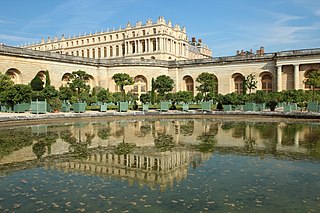
The Versailles Orangerie was built by Jules Hardouin-Mansart between 1684 and 1686, before work on the Château de Versailles had even begun. The Orangerie, which replaced Louis Le Vau's earlier design from 1663, is an example of many such prestigious extensions of grand gardens in Europe designed both to shelter tender plants and impress visitors. With the addition of the Orangerie, the gardens, no longer reserved solely for use by Louis XIV, had the added use of a theatrical setting that could be used to entertain guests at court.

Kew Gardens is a botanic garden in southwest London that houses the "largest and most diverse botanical and mycological collections in the world". Founded in 1840, from the exotic garden at Kew Park, its living collections include some of the 27,000 taxa curated by Royal Botanic Gardens, Kew, while the herbarium, one of the largest in the world, has over 8.5 million preserved plant and fungal specimens. The library contains more than 750,000 volumes, and the illustrations collection contains more than 175,000 prints and drawings of plants. It is one of London's top tourist attractions and is a World Heritage Site.

The Enid A. Haupt Conservatory is a greenhouse at the New York Botanical Garden (NYBG) in the Bronx, New York, United States. The conservatory was designed by Lord & Burnham Co. in the Italian Renaissance style. Its major design features are inspired by the Palm House at the Royal Botanic Gardens at Kew, and Joseph Paxton's Crystal Palace.

The Royal Danish Horticultural Society's Garden is a garden in the Frederiksberg district of Copenhagen, Denmark operated by the Danish Horticultural Society as a source of inspiration for its members as well as other people with an interest in gardening. It is situated on Frederiksberg Runddel, just left of the main entrance to Frederiksberg Gardens.

The New Garden in Potsdam is a park of 102.5 hectares located southwest of Berlin, Germany, in northern Potsdam and bordering on the lakes Heiliger See and Jungfernsee. Starting in 1787, Frederick William II of Prussia (1744-1797) arranged to have a new garden laid out on this site, and the design and landscaping was carried out by Johann August Eyserbeck, who had previously worked on the Dessau-Wörlitz Garden Realm.

The Orangerie in Darmstadt, built around 1720, is a baroque palace building designed by the architect Louis Remy de la Fosse. Originally, it served as a winter shelter for citrus plants sensitive to the cold, which adorned the surrounding parkland in the summer months. The building was constructed with a one-storey hall open to the south, surrounded by single-storey rooms. The adjoining orangery park was designed under Ernest Louis, Landgrave of Hesse-Darmstadt by the Electoral Palatine court gardener Johann Kaspar Ehret from Heidelberg. The symmetrical Baroque grounds consist of three tiered garden parterres, wide axes with fountains and surrounding avenues. The sandstone gate of the former market palace forms the northern end.
An orangery is a greenhouse where orange trees were protected during the winter.



